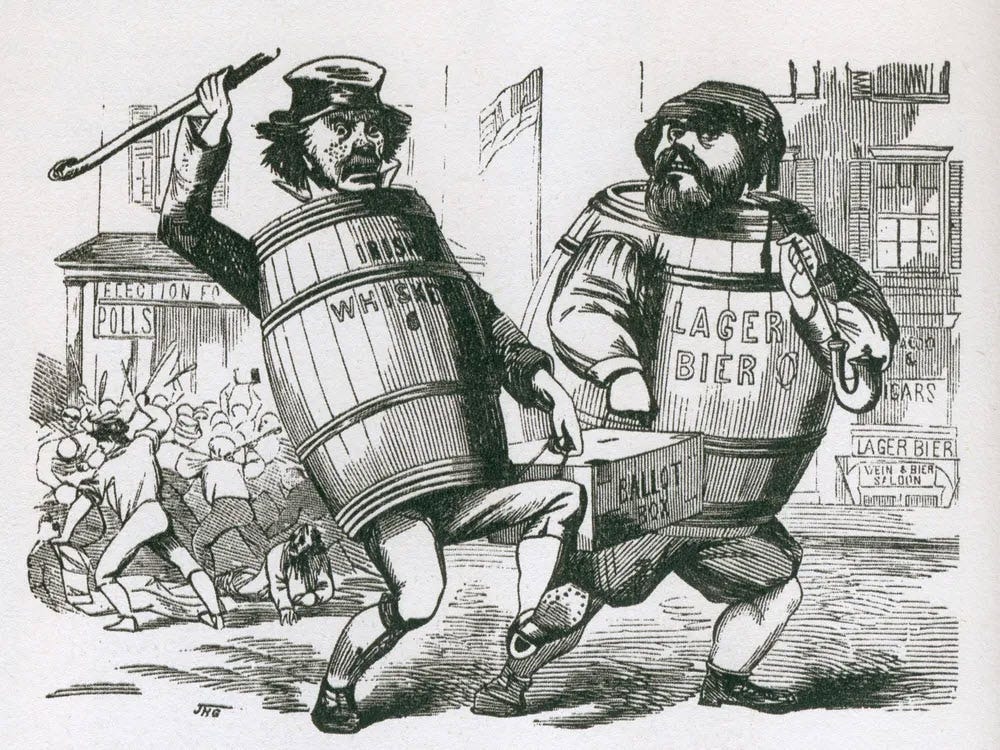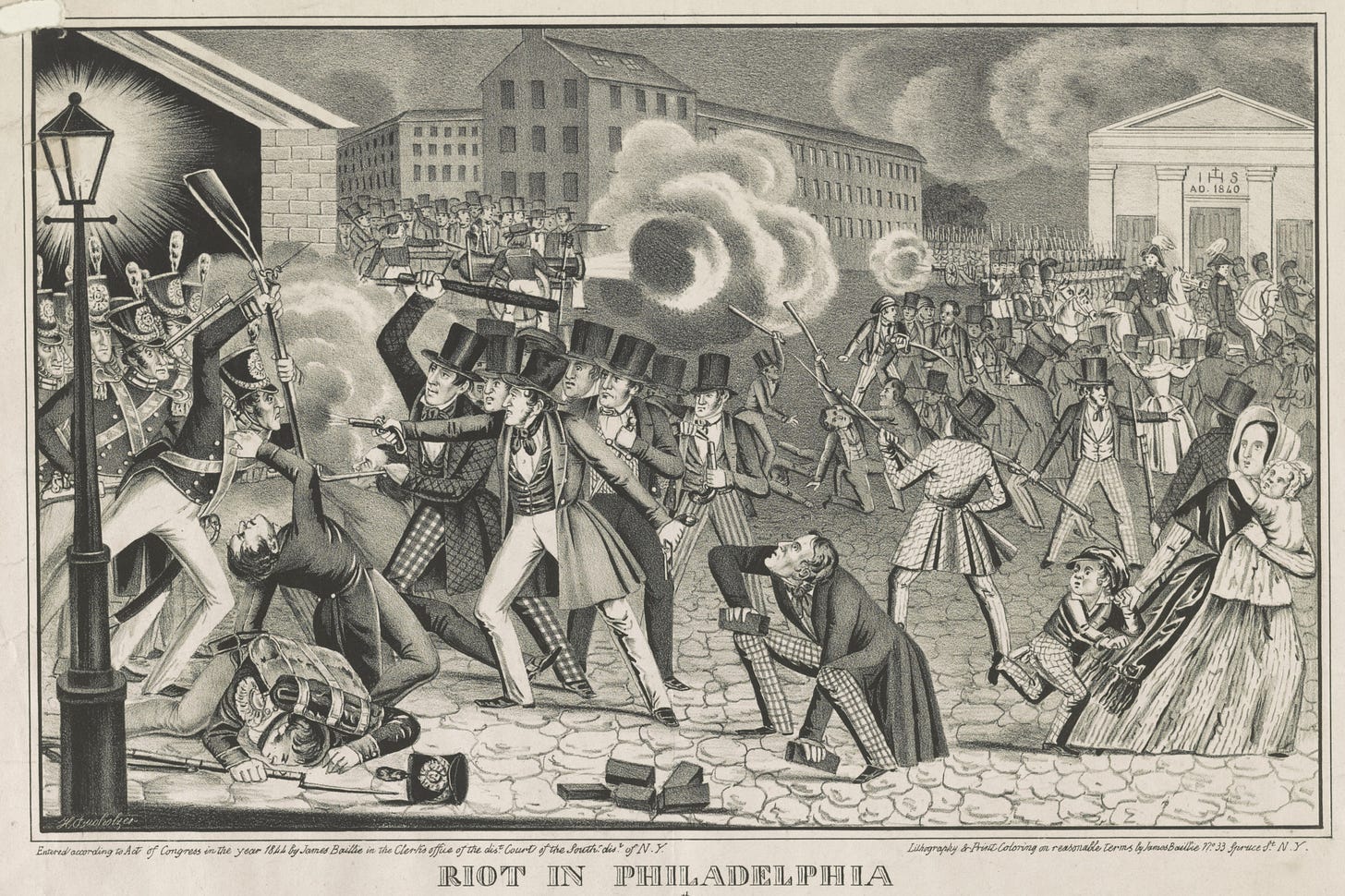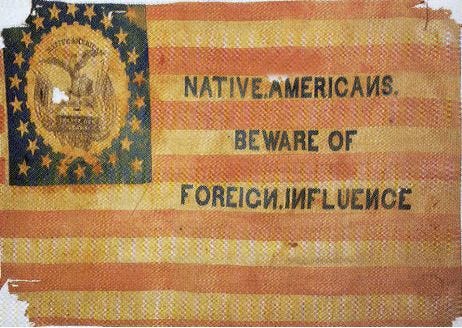Today’s GOP is a modern version of the Know Nothing Party
When it comes to immigration, we’ve been here before
I don’t normally write about history because it isn’t my strength but sometimes the irony becomes so overwhelming you just have to point it out to everyone.
We’re at one of those moments now, with the discussions and “controversy” around immigration. I put “controversy” in quotes because most rational people agree that the current immigration situation is a bureaucratic nightmare, and that something has to be done to better handle the number of people wanting to cross the southern border. Even the immigrants and asylum-seekers no doubt would prefer we get our act together since they are the ones having to deal with the mixed messages, delayed actions, and abuse.
The costs to cities around the country have been enormous. Providing shelter, food, and services to asylum seekers has cost New York an estimated $1.7B, Chicago $256M, Washington DC $56M, and Denver $25M. (source: OCHA). Everyone – US taxpayers, overworked social services professionals, residents of impacted neighborhoods, and the migrants themselves – needs and deserves a better and more effective process. I don’t know of anyone who disagrees with that.
Then there are the irrational (and/or dishonest) people, the ones who scream that the immigrants are all criminals and drug dealers and the only way to fix this mess is to build a giant wall on land and razor wire pontoons in the rivers with armed civilian militias patrolling the border and terrorizing migrant families.
I’m not going to spend time here explaining why creating a physical barrier across the entire 1,954 miles of border between the US and Mexico is impossible for geographic, logistic, economic, and political reasons. But it is impossible, as well as ineffective, and anyone saying that it is the best solution is lying to you or are themselves poorly informed.
But I do want to address the xenophobia and bigotry behind the hatred thrown toward the immigrants, and I’m going to do so by going back in history. We have been here before, and the rhetoric, the slurs, the scare tactics, the paranoia were nearly word for word the same then as it is today.
If you are familiar with US history then you’ve already guessed we’re talking about the Know Nothing Party. And if you’re familiar with the Know Nothings then you already understand how today’s Republican Party has become a modern version of it, much to the GOP’s shame.
As I write about the parallels, try to contain your astonishment at how similar the attitudes and actions of the Know Nothings of 170 years ago are to the right-wing swath of America today.
The Know Nothing Party, originally known as the American Party and also the Native American Party, emerged in the 1840s and gained strong momentum through the 1850s. While most political and ethical thinkers in the country were grappling with the ugly problem of slavery – hose to best end it and how to maintain a suitable economy in the south – a collection of nativist groups intentionally ignored the issue of slavery entirely and focused instead on attacking immigrants and Catholics. They went so far as to create false conspiracy theories urging followers toward violence.
And violence sometimes did occur. One particularly significant and ugly example was a series of riots in Philadelphia in 1844. Tensions started to build over whether Catholic children should be forced to sing Protestant hymns and read from Protestant bibles at school. Nativist groups started spreading rumors that Catholics were trying to remove bibles from schools entirely. Nativist demonstrations against Catholics in Irish neighborhoods led to four days of rioting in which Catholic churches were burned and 14 people died. (Imagine the white supremacist rally in Charlottesville, Virginia if it had gone just a little further for the worse.) When the violence started up again in July the state militia showed up and as many as 20 were dead.
All of this was mostly in reaction to the influx of German and Irish immigrants driven here by economic instability in the former and famine in the latter. The nativist groups that would eventually coalesce into the Know Nothing Party saw this as a “foreign invasion” that threatened the political and religious status quo.
“Many of these organizations played on fears that foreigners were gaining undue political influence because of the efforts of unscrupulous politicians to woo them and ‘steal’ elections,” writes Amy Briggs in National Geographic History Magazine. “Nativists often played on stereotypes depicting Irish and Germans as immoral drunkards and often blamed them for social ills, such as rising crime and poverty rates. Tensions sometimes ignited violence, with nativist riots breaking out during the 1840s and ’50s in New York, Baltimore, Philadelphia, Chicago, Cincinnati, and Louisville.”
They singled out Catholics as a major threat, as they were afraid Catholic immigrants would actively work to bring the US under control of the Pope.
As later laid out in a broadside published in 1856 called “Basic Principles of American Party of Virginia,” these nativists said they were “Determined to preserve our political institutions in their original purity and vigor, and to keep them unadulterated and unimpaired by foreign influence.”
The Know Nothing name came from a nativist secret society founded in New York City in 1849 called the Order of the Star-Spangled Banner. They intentionally used back-room methods to influence political and law enforcement activities. When anyone asked about a suspected member of the Order about what they were up to, they routinely used the answer “I know nothing” which became used by outsiders as derisive shorthand for the organization, and eventually the movement, and it stuck.
The movement claimed a lot of success in a short time, mostly on the local and regional level. Their encroachment onto the national stage was made possible partly by the collapse of the Whig Party which tore itself apart over the issue of slavery.
Writes Lorraine Boissoneault in Smithsonian Magazine, "At its height in the 1850s, the Know Nothing party included more than 100 elected congressmen, eight governors, a controlling share of half-a-dozen state legislatures from Massachusetts to California, and thousands of local politicians. Party members supported deportation of foreign beggars and criminals; a 21-year naturalization period for immigrants; mandatory Bible reading in schools; and the elimination of all Catholics from public office."
Note the Bible reference, always the fallback of American charlatans. That 1856 broadside mentioned above has as article five, “That the Bible in the hands of every free citizen is the only permanent basis of all true liberty and genuine equality.” First of all, this goes directly against the First Amendment of the US Constitution. Second, the references to “free citizens” is ironic since in 1856 that concept did not include Americans of African descent whether slaves or not, and did not include women at all. So, obviously, the phrase about “true liberty and genuine equality” was a blatant falsehood.
As the Know Nothings gained political traction they started demanding that government take a stronger role in dictating what occurs in the country. Boissoneault points out that while leaders of the Know Nothings believed in government action, it “was not in service of reducing social inequality... Only those with the proper qualifications deserved full rights. Women’s suffrage was abhorrent and unnatural, Catholics were a threat to the stability of the nation, and German and Irish immigrants undermined the old order established by the Founding Fathers."
The same then as it is today: freedom and power for me, but not for you. Also similar to what is happening today was the strong anti-elitist flavor of much of the Know Nothing rhetoric. It’s easy reading all this to substitute “Muslims” or “Jews” for “Catholics” and “Mexicans and Central Americans” for “Germans and Irish.”
What is so strange for me as I write this post is that I am descended from German farmers on both sides of my parents; my mother was a Hunsicker from the Amish regions of Pennsylvania. My other major ancestry is Scotch-Irish. My people probably came here as part of the very wave of immigration that so infuriated those nativists. I’m an old white guy, and thus in today’s world I am seen as the ethnic majority, but nearly two hundred years ago I would have been despised as an unwanted outsider, an interloper, come to bleed the US dry and change its culture for the worst. A reminder that while the details and the names change, bigotry and racism and xenophobia remain the same in their malicious harm.
This all also puts me in mind of my wife’s family. Her grandfather and grandmother both came here from the Campania region of Italy. Neither ever learned to speak English well, and we’re fairly certain her grandmother was illiterate. But they raised a family in northern New Jersey, with children who all went on to have solid careers and contribute to their communities. This is how it has always worked in the US. To criticize today’s immigrants because their English is poor or they lack modern STEM skills is missing the point entirely and is a retroactive slap in the face to families like my wife’s.
The Know Nothing Party started to lose steam in the mid-1850s at the precise moment of its greatest influence. It was one thing to focus on a single issue when you were limited to a single location. On the national stage things were immensely more complex and the Know Nothings, aka the American Party, did not have the leadership or organization to succeed at the Adult Table. Their alliances were always fragile, built as they were mostly on just the shared hatred of immigrants and Catholics, and the bonds quickly failed in the face of the extreme pressure the slavery issue was placing on the country.
It didn’t mean that the anti-immigration movement and the anti-Catholic bigotry went away, of course. These sorts of vile attitudes have a way of lingering, and evolving, occasionally emerging out into the open in the right circumstances – such as the election of Trump in 2016 or the acquisition of Twitter by Musk. The need for vigilance and the strength to take moral stands are always present.





